Reminiscences of Montville – 1938-39
Lucy O’Keefe was appointed as a teacher at the Montville State School in 1938, at the age of 21. In these reminiscences, recorded around 1994, she describes meeting with early Montville pioneers George Edward Brown and his wife Ruth and their family, and how she became lifelong friends with them, until her passing in 1996. Lucy has also recorded here tales of everyday life on the Browns’ farm and in Montville during that era.
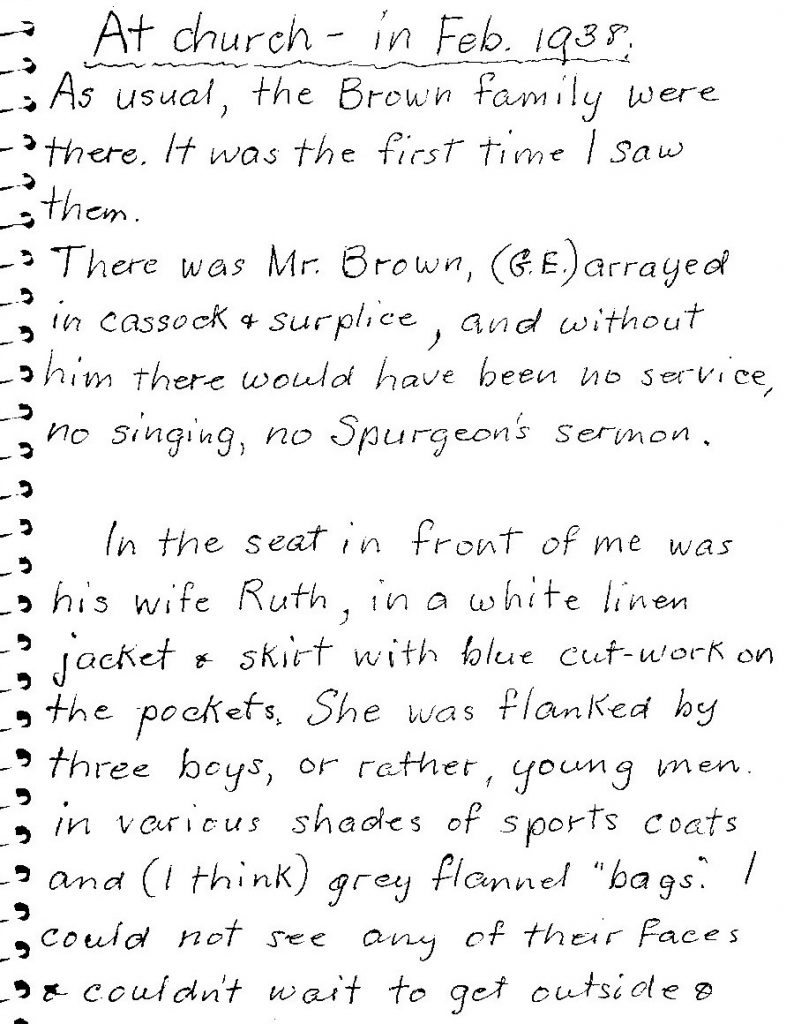
The text here is transferred verbatim from her notes, with some minor corrections and explanatory insertions, the latter shown italicised in [square brackets].
AT CHURCH – FEBRUARY 1938 [St Mary’s Anglican Church, Montville]
As usual, the Brown family were there. It was the first time I saw them.
There was Mr. Brown, (G.E.) [George Edward] arrayed in cassock and surplice, and without him there would have been no service, no singing, no Spurgeon’s sermon.
In the seat in front of me was his wife Ruth, in white linen jacket and skirt with blue cut-work on the pockets. She was flanked by three boys, or rather, young men in various shades of sports coats and (I think) grey flannel “bags”. I could not see any of their faces and couldn’t wait to get outside and have a look.
At the organ, was the Browns’ only daughter, youngest of the family [Dawne, then aged 13], obviously like her father with rosy face, only hers on that occasion looked a bit more mischievous. She wore a panama hat and of course other things, but I remember only the hat. She was pumping vigorously at the old pedal organ, doing a good job but turning towards the congregation, or perhaps it was to her own family, with a most ferocious grimace if a doubtful note sounded. As a voluntary, her “pièce de résistance” was “In the Cathedral” by Edouard Batiste.
What I didn’t know then was that I was looking at perhaps the best friends I was ever to know, in Dawne and her parents especially.
Neither did I know that those three boys sitting there with their mother were destined to be three heroes, each in his own way – Hilary the youngest joined the army while still underage, (with his father’s permission) and now sleeps in a war cemetery in N. Guinea; Roland (Pat) was to suffer blindness and illness in heroic fashion, and John was of course one of the heroes of Tobruk where he won his M.C. [Military Cross – for gallantry]
Well the service went on, in the fashion of those days, with Venite, Te Deum [‘Morning Prayer’] etc. and two of the hymns we sang were “Jesu [sic] grant me this I pray” and “To Christ the Prince of Peace”. St Mary’s is a modern, lively healthy parish now, innovative and outgoing, but to me days like that Sunday were its cradle.
Interpolation – G.E. had a sweet and trained tenor voice.
Well at last we got outside and I got a look at them. Mr. Brown was rosy, twinkly, chatty, with shortened “a” in words like “forecast”, betraying his English [Yorkshire] origin. It was obvious that he was a cultivated and educated man, which probably accounts for the fact that although his sons were not privileged to receive advanced formal education, you would never have guessed it.
But to return to that Sunday.
All the boys were fair and English looking. Their mother (Ruth) always made me think of Anne of Green Gables, with hair bordering on auburn, kindly green eyes, a powdering of freckles.
Mr. Brown looked quite different out of his surplice. He still wore the suit he was married in, with a vent in the jacket, carried a stout walking stick and wore his felt hat with a jaunty air.
I wondered what sort of home such a nice family went home to, and the next Sunday I found out, because they invited me for midday dinner, and that was my great fortune. So the next bit will be about Craglands [The Browns’ family home in Montville].
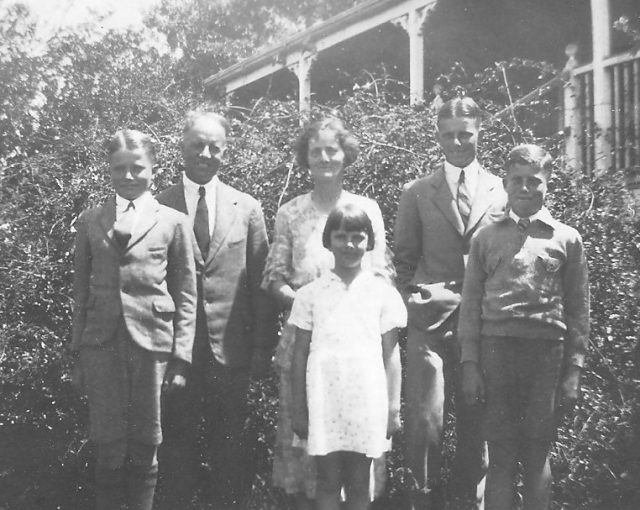
The G.E.Brown Family about 1935
FIRST VISIT TO CRAGLANDS
I think I’m a little mixed up here – the first visit was for afternoon tea on the Saturday after that church service. We had it in the garden under a huge jessamine’s shade. John and Hil [Hilary] were away at tennis or cricket – Pat came from the shed where he had been making [fruit packing] cases. I remember we all laughed so much at something or other that Pat went head over heels, chair and all, into the jessamine bush.
Ruth had made some biscuits, they were oval and had a “wipe” of icing on top, sometimes coloured pink with a little mulberry juice. She told me how she had made some like them when some ladies came to call on her when she was a young bride. Times were hard and they were made not of butter, but of dripping. They were delicious and the ladies said so, Ruth came over all modest and startled everyone by saying “Oh, but they’re only made out of dirty old fat!”
After the first visit I often went home with the family after church. It was a bit of a walk but we all chatted our way merrily along. Mr. Brown seemed to dominate, discussing various subjects. I seem to remember that he would turn his head this way and that, sort of taking in the mountain air and missing nothing. None of us was exactly taciturn.
Now for the house. Often when I stepped over the low sill to enter the living room, I would smell a mixture of violets, or later in the year freesias, and methylated [spirits]! And it was quite intoxicating. The methylated was something to do with Pat’s insulin injections [for his diabetes]. The living room itself was large, and looked rather English to me, with several chairs, including one wing chair, covered in floral print; a piano; a round table which when not in use was covered with a dark green serge (?) cloth; a lovely old sideboard, definitely not one of those heavy canopied monstrosities (we had one!)
A book shelf of very black wood with all sorts of old books in it, with interesting titles such as “The Military History of the City of Lincoln”; a corner table where I understand the kids used to have to sit if they were naughty; on top of the corner table was a huge silver tea urn, not in use in my day, but there had been lawn tennis parties in the old days …
On the sideboard was a set of chimes with a little hammer to strike them when dinner was ready. (Though I think Ruth used to summon them from the farm by beating on some round iron thing that hung near the back door.)
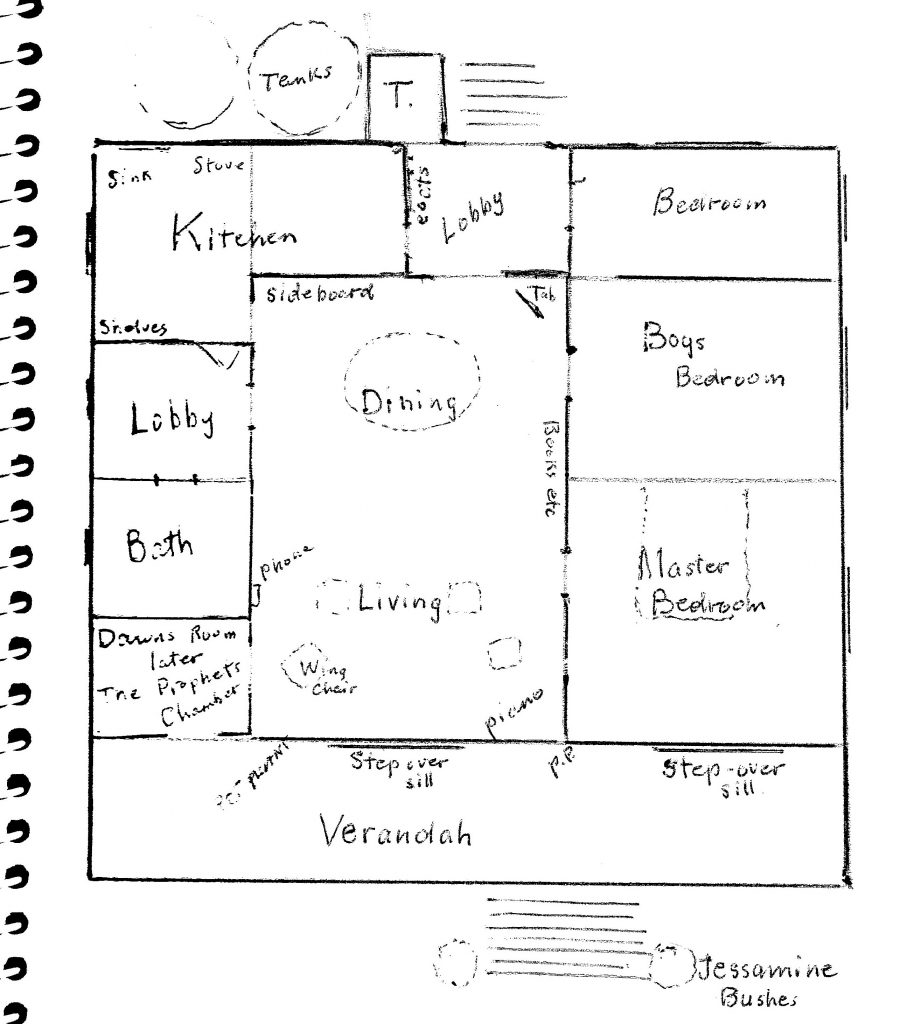
Lucy’s sketch of the ‘Craglands’ plan
Lunch, or Sunday midday dinner, was usually cold lamb with interesting salad (nobody could cut lettuce as finely as Dawne) and dressing which I remember had often crumbled egg-yolk in it. This would be followed by a superb fruit salad, and ice cream (home made) or sometimes cream (The latter usually came from their own cow, I remember G.E. saying once when she had given an unusually large quantity of milk – “She must have got excited when she heard me say I was thinking of getting her a bag of feed for the winter.”) (These little anecdotes keep cropping up.)
On the table there was always a spotless damask linen table cloth, and I remember a butter dish shaped like a silver shell with a glass lining, the salad was served in silver entrée dishes, the china was a conservative white with a dark blue border, and surely the little jug for dressing or cream was reminiscent of a little fat-bellied mouse with mousy legs and feet, only there were three legs and if I draw the third one it will give quite a wrong impression. There were always flowers and nothing spoke of riches but everything spoke of refinement
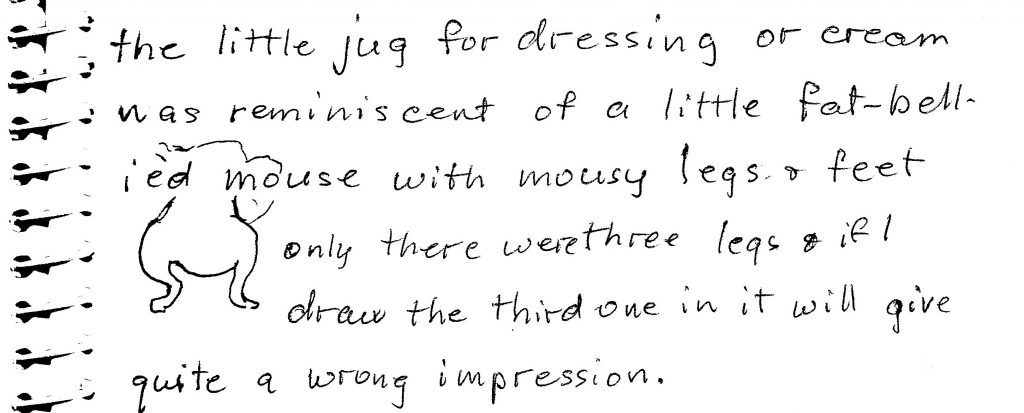
Mealtimes were always lively and some of G.E.’s best anecdotes were told there. One of the earliest was about an old chap who came out from England to work for the Browns – I think he had worked for them ‘over there’ and he called G.E. “master”. One day not long after the farm was started [in 1906] G.E. looked speculatively at a paddock being got ready for planting, and decided that some green crop first would be a good idea. He said “I think we’ll put in some cow-pea.” “Oh. master!” said the old boy. “How be ‘ee a-going to catch it?”
Later he went back to England, walking off down the road with his bundle crying out repeatedly “Goodbye master!” till he was out of sight.
THE ROMANCE
Ruth claimed to have been attracted to Ted (G.E.) first when she was about 12 [ca 1906], and he was the handsome young lay-reader who took services in Mapleton where she lived for some years. It must have been mutual because he waited for her to grow up (It sounds a bit like Jacob, who served 7 years for Rachel [a Biblical reference], but I don’t know how many years it was).
The love-affair was life-long. When she visited Craglands before they were married, it was Ted’s habit to get up early, make a little posy and throw it through the window onto her bed.
Not that one could say they never had a lover’s tiff. I am told that they even had one on their honeymoon in Sydney [in 1915]. Ruth was sweet and impulsive, and a trifle willful, so over some trifle or other she “up and left him” in the street. I don’t know much about it but he “found” her very soon, he saw her walking along a street from his seat in a tramcar so got out at the next stop, and all was well. G.E. himself told me this.
G.E. was very partial to his cup of tea. At one stage, when [his daughter] Dawne was away at school, and the boys would have been at, say, cricket, Ted would retire to one of the boys’ beds, and Ruth and I to their big bed, where we would lie and talk. It would seem like no time at all before a voice would come from the next room “Ruth”. “Yes, Ted?” “How about a cup of tea?” “Heavens. Already?” but this last was always sotto voce and she always got it for him.
At a later stage, he joined the Bowls Club, where he appeared to send the bowl off with every appearance of casualness, but results were usually very good!
As G.E. worked very hard on the farm, as he got older he would come home very tired, have his bath and subside into bed. Ruth would cheerfully wait on him, giving him his evening meal in bed. So once when she had a bit of arthritis or some such in her knee, he remarked very solemnly to me “I only hope the other knee doesn’t go.” (Tongue in cheek of course).
He was a calm and even tempered man, didn’t seem to say much to show his true feelings, or at any rate the depth of them. For example when we were all holidaying at the beach one year during the war, Mr Swain arrived one morning with the news that [George and Ruth’s son] John had been awarded the Military Cross. G.E. just said “Oh, has he? Did you get much rain up at Flaxton last night?” Or once when some of us were in a motorboat that had got weeds caught in the propeller and we looked in very real danger of being carried out to sea on the tide, he just calmly said “I’ll get into terrible trouble if my hat blows off.” And so on.
HOLIDAYS AT THE BEACH
Pleasures were simple, as to put it bluntly, money was short. But some of our best memories are of the yearly fortnight at the beach in Mr and Mrs Austin’s house, Uloola.
G.E.’s great pleasure was to fish, and he always enjoyed preparing his tackle. I remember most the “dilly-bags” into which meat was put on order to entice the worms up out of the sand. These were to be the bait. Our favourite hunting ground was the (then) deserted North Beach. A motor boat was chartered from one Percy Evans of grim visage. Sometime we had “Dawn” with the little roof over, sometimes an open boat, and each morning’s activity would be to go “worming”. I could seldom catch one, but all Browns were quick as lightning, especially Dawne. The dilly-bags were never taken back to the house, but hung up on the low growing trees until we returned the next day. In the course of a few days they got exceedingly smelly: so we were quite sure nobody would ever pinch them. And the riper they grew, the more the worms loved them.
FOOD
Fish were either caught or bought so they were fried for lunch each day. (No fish and chips from a shop in those days, thank you!) And of course there was salad. When the first course was finished, someone was dispatched to the little shop up the road to fetch a block of ice cream to eat with the incomparable fruit salad brought down from “The Range” – bananas, pawpaws, passion fruit, pineapple etc.
BACK TO CRAGLANDS
There was a time when G.E. decided that the two jessamines on either side of the front steps needed trimming, so he got out a brush-hook to do the job. Immediately, all the female voices called out to him with instructions not to cut too much, etc.etc. “Back to your kennels, all of you” he said, but he said it under his breath.
It was nothing unusual to arrive at ‘Craglands’ and find a baby in residence because many a mother was glad and relieved to leave her baby in the care of Ruth B. in any kind of emergency. She loved them all, a trait which has persisted into the third generation.
Sometimes, G.E. washed up and his great saying was “If you don’t like the look of anything, put it back in the dish. BUT DON’T TALK ABOUT IT.”
He was a great raconteur, and many were the tales he told, from adventures while carol-singing in Yorkshire, which I’m sure I’m not allowed to tell here, to the one which seems most popular.
LAY READING AT KENILWORTH
Sometimes G.E. went on horseback to Kenilworth to conduct a service. Of course this was in his young, single days. It was a long, steep ride and one kind lady used to give him lunch. One day she made a hard white suet pudding which he manfully ate, but when she insisted on giving him a second helping, he watched his opportunity and slipped the slice into his pocket when she was not looking. On his way home, crossing the Obi river, he threw it into the water (and here’s the embroidery) and says it killed a fish.
There was usually just a little embroidery!
It used to rain a great deal more in Montville in those days than it does now, and the roads were unsealed and muddy. The kids would arrive home from school wet and cold. Ruth would always have hot water (heated on the stove in those days) ready, and often warm dry pyjamas for them to put on, and a hot drink. On one particularly nasty day, Dawne received the full treatment. When she came out of the bedroom, she wasn’t in her pyjamas etc. at all, but dressed up ready to go out. It was the night for the travelling picture show’s visit out at the hall, and she had no intention of missing it – though I don’t know what really happened.
LIFE WENT ON
Life went on, one year rolled by after another. I have yet to see anything lovelier than a citrus orchard in full bloom, but the returns from citrus were not great, and it was Ruth who had to make the money go round, and her hard work that provided such creature comforts as the family enjoyed. When I first went there, her toaster was a home made affair of tangled wire, over the wood stove and so on. One of the boys bought a packet of seeds (about 6d [sixpence] in those days) and was told “You don’t buy seeds, you get them from your friends!”
But ‘Craglands’ was always a home. When the farm went out of citrus and into pineapples they paid better and things improved, and such things appeared as a new bath, a wonderful Ucinski hot water system that still provides unlimited hot showers for as many as 12 or 13 at holiday times, and greatest of joys, a septic tank. Apropos of the latter, a little room had to be squeezed in, and one of the rather elderly local gentlemen who came to build it had been making patriotic speeches about “the bombs falling on London” only he pronounced it as “bumbs”, and G.E. was heard to whisper “I hope he makes it bumb proof.”
After the pineapples “came in” one no longer hears such things as “When I was over in the Cantons” [a type of mandarin] or “Pat is in the Navels” or “The Valencias are doing well” or “We’ll pick the Scarlets” – fascinating names [for three types of oranges].
However …
The children had always played lots of sport. At the beginning of my association (about 1938) they also, like their parents took a great interest, and John especially took office, in local institutions such as the School of Arts library, the recording of rainfall [the Brown and Barnett families were official local recorders for the Weather Bureau for over 100 years], the Pastime Club and so on. They were a family of leaders.
Dawne still plays a few leading roles, solidly supported by Tony [her husband Tony Barnett], who rarely appears out front, but does more to “push the barrow” of community well-being than anybody I know. Lots of people call on him for all kinds of help, and no-one as far as I can see has ever called in vain.
Fruit-growers meetings could sometimes get a bit contentious. G.E. could usually pour oil on troubled waters (“Blessed are the peace-makers”?)
I recall him at the school Breaking Up picnic, in charge of the water-boiling operations, staggering with a kerosene tin full of billy tea, up to the ladies who were preparing lunch, beaming at them all and calling them “girls” in the most natural way, which I think they all loved. At that picnic we got news that the “Bartolomeo Colleoni” had been sunk. Right in the “Italian Lake!” (Just by the way.) [The ‘Bartolomeo Colleoni’ was an Italian warship, sunk by HMAS Sydney and others in 1940]
The old days were great days, happy days and sad days. The evening of the day war was declared there was a most unhappy and anxious Evensong in St Mary’s, and as Dawne was away at school [St Margaret’s school in Brisbane]. I believe I am the only person still living who remembers it. We little knew of what was to come. It was the end of the Pastime Club, the end of our Sunday-School picnics to the beach. (We used to go in Peter Smith’s old utility, and loud were the cheers at the first sight of the sea).
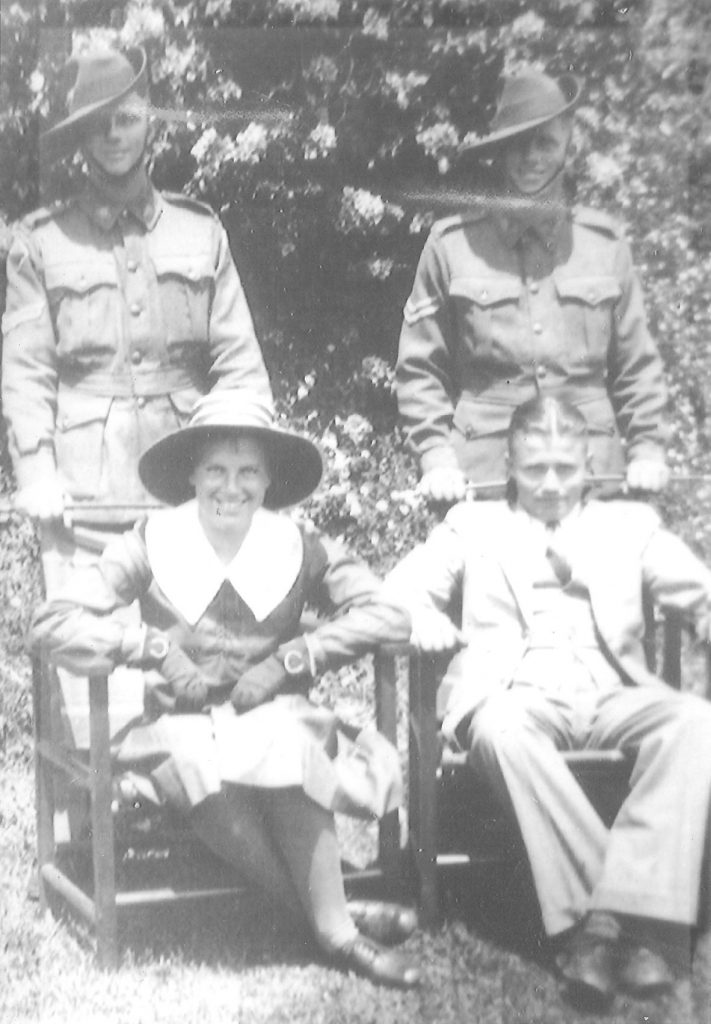
John and Hilary (in army uniforms); Dawne and Pat (ca 1940)
Sadnesses have healed, gaps have (almost) closed and there are new wonderful generations at morning tea on the verandahs of new Craglands [the new house, built in the 1970s]. But they are another story, interesting but too long for me to write about; and anyway it is well able to be seen first hand, and grows with every year.
57 years of friendship, and hopefully a few more to come. Wasn’t I lucky.
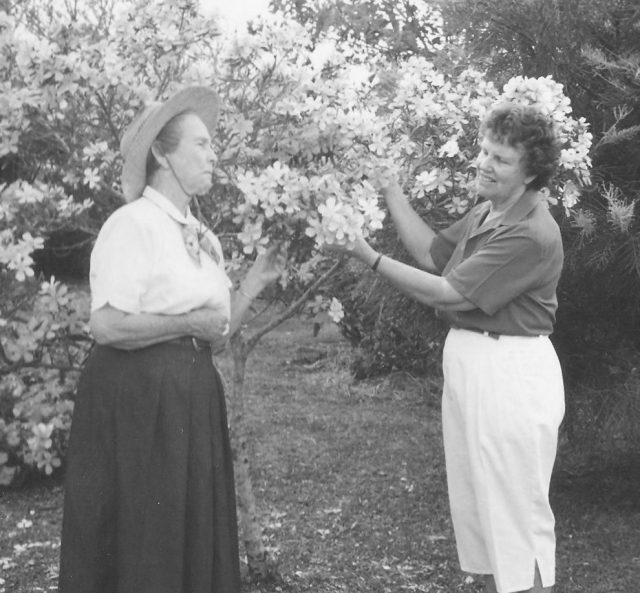
Lucy and Dawne in the garden at ‘Craglands’ (ca 1990)
NOTES
Lucy Mary Washington O’Keefe
Lucy was born in Brisbane in 1916. She attended the Brisbane Normal [Primary] School in Adelaide Street in the city, and then the Brisbane State High School in South Brisbane. She qualified as a primary school teacher in 1937, and then taught at the Montville State School for the next two years, before being transferred to the Bli Bli School in 1940.
Lucy remained friends with the Brown family and was a regular guest at their house ‘Craglands’, until her passing in 1996 at the age of 80. Lucy’s ashes were planted with a Silky Oak tree at ‘Craglands’, on a hill overlooking the valley and the Baroon Pocket Dam.
George Edward Brown and Ruth Seccombe
George was born in York, England, in 1885. He migrated to Australia in the early 1900s with his family, and they bought a property of around 80 acres on Balmoral Road Montville, in 1906. They named the property ‘Craglands’ and established a citrus farm there (later converted to a pineapple farm).
George married Ruth Seccombe (born 1894 in Tilba Tilba, NSW) in 1915, and they had three sons: John, Hilary and Roland (known as ‘Pat’) and one daughter (Dawne). George passed away in 1968 at the age of 83, and Ruth followed him in 1983, at the age of 90.
A portion of the original ‘Craglands’ property remains in the family.
For more information, please refer to the story ‘The G.E. Brown Family’ on this website.
Lucy O’Keefe’s reminiscences were transcribed, with notes added, by Peter Eedy (Tony and Dawne Barnett’s son-in-law), Brisbane, May 2019.

 ©2016 Montville History Group. All rights reserved.
©2016 Montville History Group. All rights reserved.